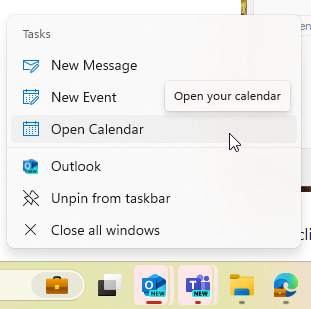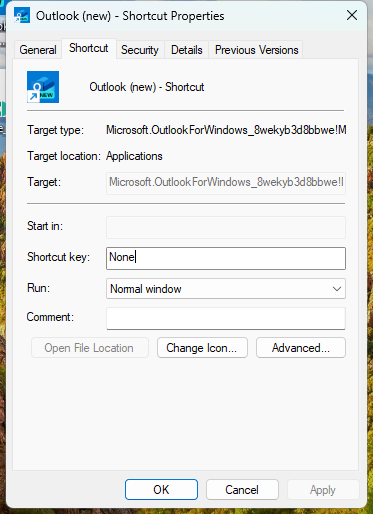Invoking New Outlook
I was trying to work out how to add a button to open the Calendar in New Outlook (the replacement for Outlook, which basically seems to be a shell round the outlook.office.com PWA) to my Stream Deck. As such I needed a command line I could run from PowerShell. This turns out to be more complicated than it seems.
It's definitely possible, thought, there's a Jump Menu option to do it:

New Outlook is not a normal windows executable
In the olden days, you'd just invoke outlook.exe with command line switches. However, when I try this, it gets me to the Old Outlook, and I want New Outlook.
It turns out that New Outlook is actually a Universal Windows Platform (UWP) app of the type distributed with the Microsoft Store.
Finding out how to invoke New Outlook - the UWP Shortcut
By going to shell:AppsFolder in explorer, you can see the UWP applications list, scroll to Outlook (New), right click and Create a Shortcut. This will create .lnk file in the desktop:

double-clicking or invoking this link will open outlook.
Listing UWP apps in powershell
To get this on powershell:
❯ Get-AppxPackage | Where-Object Name -Like "*utlook*"
RunspaceId : 999a8d9a-04d0-4cee-b3ff-9a2072661058
Name : Microsoft.OutlookForWindows
Publisher : CN=Microsoft Corporation, O=Microsoft Corporation, L=Redmond, S=Washington, C=US
PublisherId : 8wekyb3d8bbwe
Architecture : X64
ResourceId :
Version : 1.2023.1018.300
PackageFamilyName : Microsoft.OutlookForWindows_8wekyb3d8bbwe
PackageFullName : Microsoft.OutlookForWindows_1.2023.1018.300_x64__8wekyb3d8bbwe
InstallLocation : C:\Program Files\WindowsApps\Microsoft.OutlookForWindows_1.2023.1018.300_x64__8wekyb3d8bbwe
IsFramework : False
PackageUserInformation : {}
IsResourcePackage : False
IsBundle : False
IsDevelopmentMode : False
NonRemovable : False
Dependencies : {}
IsPartiallyStaged : False
SignatureKind : Developer
Status : Ok
The PackageFamilyName is the same as that shortcut link
However, as per How to Open a Windows Modern UWP App From the Command Line | The Poet Engineer (postach.io) we also need to find the App Name in order to create the URL. We can do this with the PackageFullName from above
❯ (Get-AppxPackageManifest Microsoft.OutlookForWindows_1.2023.1018.300_x64__8wekyb3d8bbwe).package.Applications.Application
EntryPoint : Windows.FullTrustApplication
Executable : olk.exe
Id : Microsoft.OutlookforWindows
VisualElements : VisualElements
Extensions : Extensions
The Appname here is thus Microsoft.OutlookforWindows.
We can now compose the full command into shell:AppsFolder\Microsoft.OutlookForWindows_8wekyb3d8bbwe!Microsoft.OutlookForWindowsand run it using:
> Start-Process shell:AppsFolder\Microsoft.OutlookForWindows_8wekyb3d8bbwe!Microsoft.OutlookForWindows
This, however won't show the calendar.
Getting to the calendar
From the Application above we see the executable is called olk.exe- we can also discover this from the task manager.
As per reddit, if we open the calendar from the Taskbar Jump Menu, we can then query the Windows CMI to get the command line:
❯ Get-CimInstance Win32_process | Where-Object {$_.Name -eq 'olk.exe'} | Select-Object CommandLine | Out-String -width 250
CommandLine
-----------
"C:\Program Files\WindowsApps\Microsoft.OutlookForWindows_1.2023.1018.300_x64__8wekyb3d8bbwe\olk.exe" ms-outlook:launch?calendar
That's how you can invoke it:
❯ Start-Process shell:Appsfolder\Microsoft.OutlookForWindows_8wekyb3d8bbwe!Microsoft.OutlookforWindows ms-outlook:launch?calendar
It's a URI!
But wait, that last bit looks suspiciously like a URI.
In fact, it is, and just running ms-outlook:launch?calendar will do the same thing.
I can't seem to find much information on the ms-outlook URI scheme, it doesn't appear to be documented officially, but it does look like there are some fun things that can be done with it. I'll have to experiment with whether it's similar to the PWA URLs